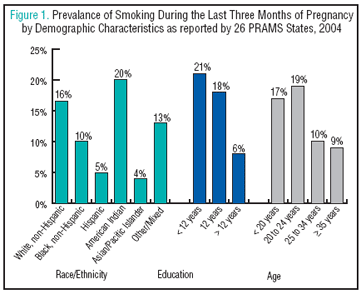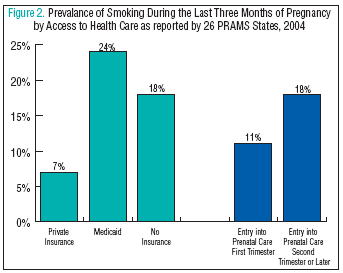 |
|
 |
 |
 |
Preventing Smoking and Exposure to Secondhand Smoke Before, During, and
After Pregnancy
The Reality
Smoking before and during pregnancy is the single most preventable cause
of illness and death among mothers and infants. Women who quit smoking
before or early in pregnancy significantly reduce the risk for several
adverse outcomes.
- Compared with women who do not smoke,
- Women who smoke prior to pregnancy are about twice as likely to
experience a delay in conception and have approximately 30% higher
odds of being infertile,
- Women who smoke during pregnancy are about twice as likely to
experience premature rupture of membranes, placental abruption, and
placenta previa during pregnancy.
- Babies born to women who smoke during pregnancy,
- Have about 30% higher odds of being born prematurely.
- Are more likely to be born with low birth weight (less
than 2500 grams or 5.5 pounds), increasing their risk for illness or
death.
- Weigh an average of 200 grams less than infants born to women
who do not smoke.
- Are 1.4 to 3.0 times more likely to die of Sudden Infant
Death Syndrome (SIDS).
Prevalence of Smoking During The Last 3 Months of Pregnancy
According to 2004 Pregnancy Risk Assessment Monitoring System (PRAMS) data
from 26 states,1
- Approximately 13% of women reported smoking during the last 3
months of pregnancy.
- Younger, less educated, non-Hispanic white, and American Indian
women are more likely to smoke during pregnancy compared with their
older, more educated counterparts (Figure 1).

(A
text
version of this graphic is also available.)
- Women on Medicaid are more than three times as likely to smoke
during the last 3 months of pregnancy as women with private insurance,
and smoking rates are higher among women who enter into prenatal care
later in pregnancy (Figure 2).

(A
text
version of this graphic is also available.)
- Of women who smoked during the last 3 months of pregnancy, 52%
reported smoking 5 or fewer cigarettes per day, 27% reported smoking 6
to 10 cigarettes per day, and 21% reported smoking 11 or more cigarettes
per day.
- Of women who smoked 3 months before pregnancy, 45% quit during
pregnancy. Among quitters during pregnancy, 52% relapsed within 6 months
after delivery. The financial burden of smoking during pregnancy is even greater today
than these figures indicate because medical care costs have risen
substantially in recent years, by more than 14% between 1996 and 2000.
Secondhand Smoke
 Exposure to secondhand smoke causes premature death and disease in
children and adults who do not smoke. Exposure to secondhand smoke causes premature death and disease in
children and adults who do not smoke.
- From 1988 through 2002, cotinine levels (a biological indicator of
tobacco smoke exposure) declined by approximately 70% among children and
nonsmoking adults. Despite this positive trend, in 2002 nearly half
of
all children and nonsmoking adults still had
detectable levels of cotinine.
- Pregnant women who are exposed to secondhand
smoke have a 20% higher
odds of giving birth to a low-birth weight baby than women who are not
exposed to secondhand smoke during pregnancy.
- Children are at greater risk of being exposed to secondhand smoke
than adults.
- During the period 1999-2002, almost 40 million children aged 3 to
19, or about 58% of children in this age group, were exposed to
secondhand smoke.
- Infants who are exposed to secondhand smoke are more likely to die
of SIDS compared with infants who are not exposed.
- Children who are exposed to secondhand smoke are at increased risk
for bronchitis, pneumonia, ear infections, severe asthma, respiratory
symptoms, and slowed lung growth.
Recommended Strategies & Policies
Prevent smoking initiation among young people.
- Increasing the unit price for tobacco products and conducting mass
media campaigns in combination with other interventions (such as
school-based education and community education) effectively prevents
young people from initiating smoking.
Help pregnant women quit and prevent relapse.
- Because pregnant women who have received brief smoking cessation
counseling are more likely to quit smoking, clinicians should offer
effective smoking cessation interventions to pregnant smokers at the
first prenatal visit and throughout the pregnancy.
- Medicaid coverage of smoking cessation counseling services and
medications is associated with lower smoking rates among women.
- Increasing the unit price for tobacco products can reduce rates of
smoking during pregnancy and relapse after delivery.
Take Action
The Surgeon General has concluded that the only way to fully protect
yourself and your loved ones from the dangers of tobacco smoke is to live in
and visit only 100% smoke-free environments.
For more information and references supporting these facts, visit
www.cdc.gov/nccdphp. For
additional copies of this document, E-mail
cdcinfo@cdc.gov.

1. PRAMS 2004 representing 26 states. Division of
Reproductive Health, National Center for Chronic Disease Prevention and
Health Promotion, Centers for Disease Control and Prevention.
* Links to non-Federal
organizations are provided solely as a service to our users. Links do not
constitute an endorsement of any organization by CDC or the Federal
Government, and none should be inferred. The CDC is not responsible for
the content of the individual organization Web pages found at this link.
 One or more documents on this Web page is available in Portable Document Format
(PDF). You will need Acrobat
Reader (a free application) to view and print these documents.
One or more documents on this Web page is available in Portable Document Format
(PDF). You will need Acrobat
Reader (a free application) to view and print these documents.
Department of
Health and Human Services
Centers for Disease Control and Prevention |
 |
Page last reviewed: October 3, 2007
Page last modified: October 3, 2007
Content source: National Center for
Chronic Disease Prevention and Health Promotion
|
 |